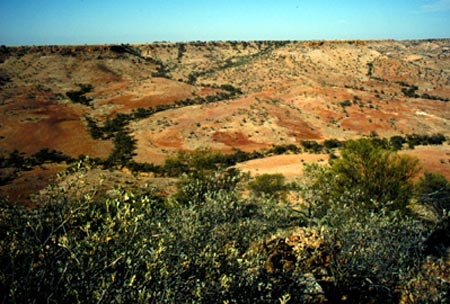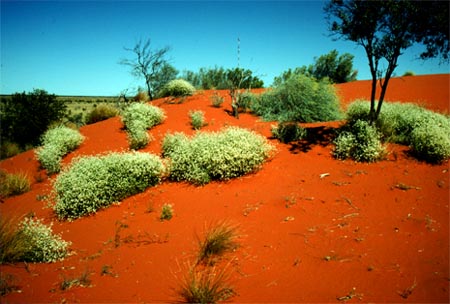Therevidae collecting trips report, 1997-1998, Yeates Systematics lab
by Shaun Winterton
A series of collecting trips in Australia for Therevidae were conducted during 1997 and early 1998. All trips were undertaken in conjunction with collection trips by other students and researchers in the University of Queensland, Entomology department investigating other target groups such as Pipunculidae (Jeff Skevington), Lasiocampidae (Andreas Zwick) and Bombyliidae (Christine Lambkin). Collecting was done using malaise traps, light traps, and handnetting.
Birdsville (Central Australia)-September 1997

During the first week of September, Shaun Winterton, Jeff and Angela Skevington, Christine Lambkin, and Andreas Zwick drove to central Australia near the intersection of the South Australian, New South Wales and Queensland borders. Malaise traps were erected in spinifex sand-dune country and dry creek beds near Windorah. The main collections were made at Goyder lagoon (South Australia), 300 km south of Birdsville. Many therevids of the genus Parapsilocephala Kröber were collected hill topping on sand-dunes in the area. A strikingly coloured, undescribed species of Anabarhynchus Macquart was the highlight of collecting in the area. The daytime temperatures reached 35 degrees C, while night were still quite cool. While early in the season for therevid activity, many species were collected, including members of the genera Acraspisa Kröber, Parapsilocephala,Anabarhynchus, Bonjeania Irwin and Lyneborg, and several undescribed genera.

Wyperfeld National Park/Adelaide region/ Flinders ranges– September October 1997
The major collecting trip for 1997, Shaun Winterton, Jeff and Angela Skevington and Christine Lambkin covered nearly 10,000 kilometres travelling through New South Wales Victoria and South Australia by 4WD. The first stop was collecting in Wyperfeld National Park in far western Victoria. Typical sandy heath country several species of Therevidae were collected including two species ofEctinorhynchus Macquart and a single species of Anabarhynchus. Hill topping on a large sand dune were a undescribed species of Parapsilocephala and an undescribed and previously uncollected species of a new genus being described by Winterton and Irwin.
During the first week the group attended the Systematic Biology conference in Adelaide while running malaise traps near Gawler and Swan Reach. Various species of Acraspisa, Parapsilocephala and Ectinorhynchus were collected. The habitat around Swan Reach is dry, open, mallee forest with large numbers of wombats living in the area. During the second and third weeks the group collected in the southern Flinders Ranges at Dutchman’s Stern and Flinders Ranges National Parks. The relatively recent history of intense stock grazing in the region meant that there was little therevid habitat left and collecting reflected this. The best collecting was found in mulga country in the Love Ranges, 50 km to the east. Here we collected large numbers of apparently early season therevids such as Ectinorhynchus,Parapsilocephala, Anabarhynchus and two species of Agapophytus Guérin-Méneville.
Warrumbungle National Park. October-November 1997
Situated in north-central New South Wales, Warrumbungle NP is rapidly becoming a Mecca for Therevidae collecting. Large numbers of therevids can be collected during the warm season in this area and this collecting trip was no different. No therevid collecting has been done previously during October in this Park. Shaun Winterton, Jeff and Angela Skevington and Christine Lambkin collected in the area for 4 days using malaise traps and handnetting. Two traps were then left set-up in the park, one at the “Woolshed” and one at “Camp Blackman”, for two weeks when Shaun Winterton returned to collect them. Approximately 3000 therevids were collected between the two traps. Over 20 species were collected from 15 genera such as Agapophytus Guérin-Méneville,Anabarhynchus Macquart, Acupalpa Kröber, Parapsilocephala Kröber,Bonjeania Irwin & Lyneborg, and Neodialineura Mann and three new genera. A highlight was large numbers of the rarely collected genera Taenogera Kröber and another new genus, which were the dominant species in the trap. The species composition of the trap sample is particularly interesting since collecting trips by M.E. Irwin et al. in previous years during December-January have yielded large trap samples of totally different species and genera. This indicates a dramatic change in the temporal phenology of therevid diversity in the region. Many more collecting trips are planned for the region in the future.